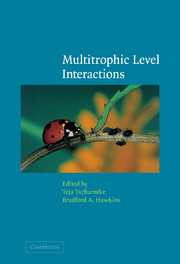Book contents
- Frontmatter
- Contents
- List of contributors
- 1 Multitrophic level interactions: an introduction
- 2 Plant genetic variation in tritrophic interactions
- 3 Multitrophic/multispecies mutualistic interactions: the role of non-mutualists in shaping and mediating mutualisms
- 4 Tritrophic interactions in tropical versus temperate communities
- 5 Endophytic fungi and interactions among host plants, herbivores, and natural enemies
- 6 Multitrophic interactions in space: metacommunity dynamics in fragmented landscapes
- 7 The chemical ecology of plant–caterpillar–parasitoid interactions
- 8 Canopy architecture and multitrophic interactions
- 9 Tritrophic below- and above-ground interactions in succession
- 10 Multitrophic interactions in decomposer food-webs
- Index
10 - Multitrophic interactions in decomposer food-webs
Published online by Cambridge University Press: 08 August 2009
- Frontmatter
- Contents
- List of contributors
- 1 Multitrophic level interactions: an introduction
- 2 Plant genetic variation in tritrophic interactions
- 3 Multitrophic/multispecies mutualistic interactions: the role of non-mutualists in shaping and mediating mutualisms
- 4 Tritrophic interactions in tropical versus temperate communities
- 5 Endophytic fungi and interactions among host plants, herbivores, and natural enemies
- 6 Multitrophic interactions in space: metacommunity dynamics in fragmented landscapes
- 7 The chemical ecology of plant–caterpillar–parasitoid interactions
- 8 Canopy architecture and multitrophic interactions
- 9 Tritrophic below- and above-ground interactions in succession
- 10 Multitrophic interactions in decomposer food-webs
- Index
Summary
Introduction
Trophic interactions in soil form the basis of virtually all terrestrial life. Without the recycling of plant materials produced above the ground, and the mineralization of the nutrients therein, plant life would cease quickly and with it the whole above-ground food-web. It is surprising therefore that, in comparison to aquatic food-webs and food-webs above the ground, the below-ground community has received little attention. One of the major intentions in writing this review was to emphasize this gap and to outline that the lack of knowledge on food-web interactions in below-ground systems is a major constraint in current ecological thinking.
We will stress in this review that below-ground systems are unique in several respects and that, due to this uniqueness, the understanding of interactions in below-ground systems may significantly enrich the way we perceive nature. Since from the energetic perspective the below-ground decomposer system is far more important than the herbivore system above the ground, it is certainly necessary to include the peculiarities of below-ground food-webs into ecological thought. Although this has been realized by various people (Beare et al., 1995; Wardle and Giller, 1996; Bengtsson, 1998; Young and Ritz, 1998; Scheu et al., 1999b; Villani et al., 1999; Wall and Moore, 1999), the bias in terrestrial ecology towards above-ground systems has experienced little change.
- Type
- Chapter
- Information
- Multitrophic Level Interactions , pp. 223 - 264Publisher: Cambridge University PressPrint publication year: 2002
- 88
- Cited by



